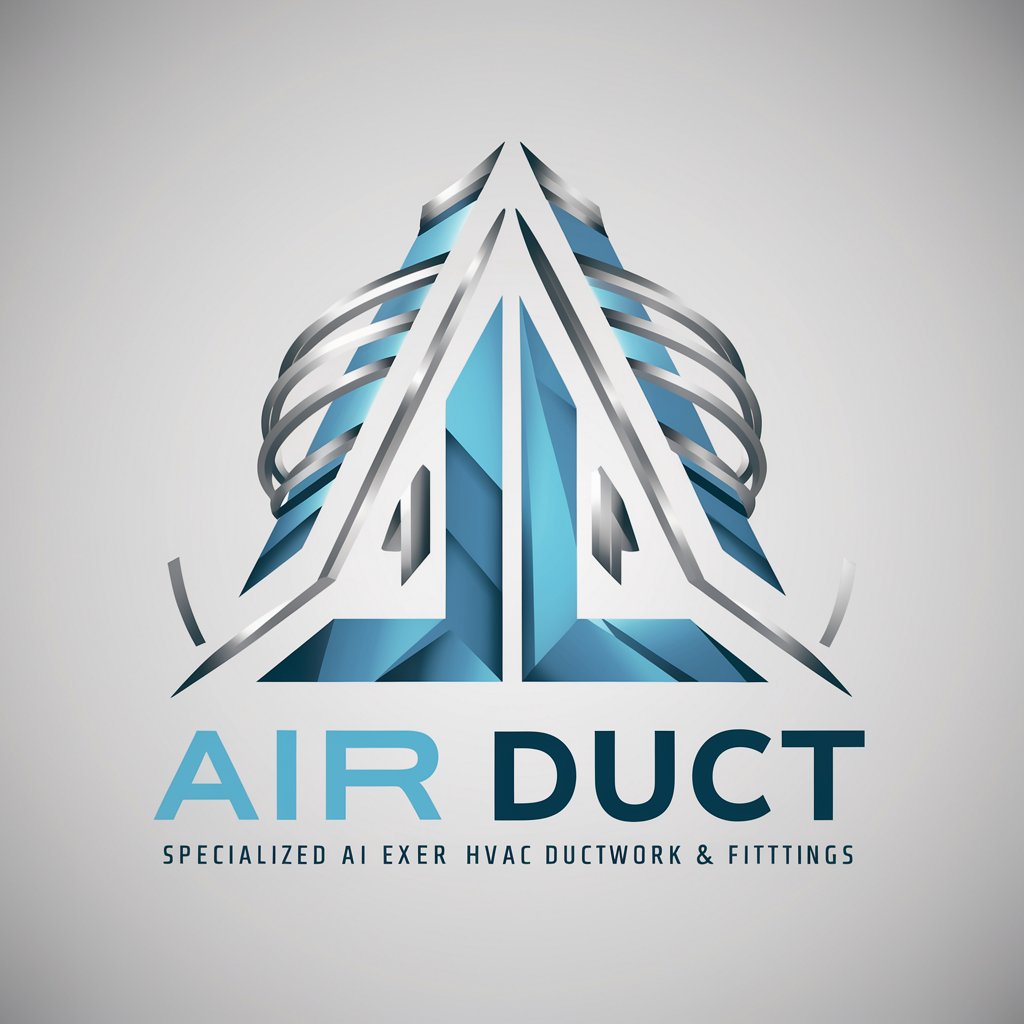
Air Duct - HVAC Ductwork Insights

Hello! How can I assist you with your HVAC ductwork questions today?
Elevate Your Air Quality with AI
Can you explain the differences between flexible and rigid air ducts?
What are the best practices for installing HVAC ductwork in a residential building?
How do I properly maintain and clean my HVAC duct system?
What are the common materials used for HVAC ducts and their respective advantages?
Get Embed Code
Understanding Air Ducts in HVAC Systems
Air ducts are pivotal components in heating, ventilation, and air conditioning (HVAC) systems. They serve as pathways for heated or cooled air to travel throughout a building. The design purpose of air ducts is to ensure efficient and effective distribution of air to maintain indoor air quality and thermal comfort. Made from materials such as sheet metal, fiberglass, or flexible plastic and wire composite, air ducts are designed to meet various building codes and standards. For instance, in a residential setting, flexible ducts may be used in tight spaces to connect the main ductwork to room registers. Conversely, in commercial buildings, rigid sheet metal ducts are often utilized for their durability and airflow efficiency. Powered by ChatGPT-4o。

Core Functions of Air Ducts in HVAC Systems
Distribution of Conditioned Air
Example
In a central air conditioning system, air ducts distribute cooled air from the air handler to various rooms, ensuring a uniform temperature throughout the space.
Scenario
During a hot summer day, an office building utilizes its HVAC system's air ducts to deliver cool air to all offices, maintaining a comfortable working environment.
Return of Air to HVAC Equipment
Example
Air ducts also facilitate the return of air back to HVAC equipment for reconditioning, maintaining efficient system operation.
Scenario
In a home, return air ducts collect air from various rooms to be filtered and re-cooled by the HVAC unit, ensuring that air circulated in the house is clean and at the desired temperature.
Ventilation and Air Quality Control
Example
Specific ductwork designs, such as those with integrated filters or air purifiers, help improve indoor air quality by removing pollutants and allergens.
Scenario
Hospitals use specialized air duct systems with HEPA filters to ensure that the air in patient care areas is free from contaminants, critical for infection control.
Target User Groups for Air Duct Services
HVAC Professionals
This group includes installers, service technicians, and engineers who design, install, and maintain air duct systems. They benefit from understanding the complexities of ductwork to ensure systems are efficient, comply with standards, and meet the specific needs of the building's occupants.
Building Owners and Managers
Owners and managers of residential, commercial, and industrial properties rely on efficient air duct systems to provide comfortable, healthy environments for occupants. Knowledge of air duct functionality and maintenance can help in making informed decisions regarding HVAC investments and operations.
Environmental Health and Safety Specialists
Specialists in this field focus on ensuring indoor air quality and thermal comfort for building occupants. They utilize air duct systems to mitigate health risks associated with poor air quality, such as allergens and pollutants, by implementing proper ventilation and filtration solutions.

How to Use Air Duct
1
Start by visiting yeschat.ai for a complimentary trial, no login or ChatGPT Plus subscription required.
2
Identify your specific HVAC ductwork question or problem to get the most relevant advice or information.
3
Navigate through the provided categories or use the search function to find specific topics related to air ducts and HVAC systems.
4
Read through the guidelines, tips, and answers provided for your query to gain comprehensive insights.
5
Apply the advice or information to your HVAC ductwork project, ensuring to follow any safety standards and best practices mentioned.
Try other advanced and practical GPTs
FinSight AI
Empowering Finance with AI

FUSION MECHANICS
Innovate, Crossbreed, and Mint Ideas with AI

Generador de SEO FAQs
Elevate SEO with AI-driven FAQs

One teaspoon GPT Category Content
Crafting Your Brand's Story with AI

美食我最行
Explore Chinese cuisine with AI

Medium Mastermind
Elevate your Medium posts with AI

Kiddo Genius Hub
Empowering Young Minds with AI

Buscador Experto
AI-Powered Precision in Online Searches

FroheBuchstaben: Eine Reise in die Welt des Lesens
Empowering Your German Reading Journey with AI

Wealth Advisor
Empowering Your Wealth with AI

Headline Rumus 1 C3H
Craft Compelling Headlines with AI

Game Reviews
Your AI-Powered Game Advisor

Air Duct Q&A
What materials are commonly used in air duct systems?
Air duct systems primarily utilize materials such as galvanized steel, aluminum, fiberglass duct board, and flexible ducting, each chosen based on the application, durability, cost, and installation requirements.
How often should air ducts be cleaned?
Air ducts should be cleaned every 3 to 5 years, but this can vary based on factors like usage, location, and if there are pets or individuals with allergies in the household.
What are the benefits of sealing air ducts?
Sealing air ducts improves efficiency by reducing air loss, lowers energy bills, improves indoor air quality by preventing contaminants from entering the system, and ensures more consistent room-to-room temperatures.
Can I install air ducts myself?
While DIY installation is possible, it requires a good understanding of HVAC systems, the right tools, and adherence to building codes. Professional installation is recommended for optimal system performance and safety.
How do I know if my air ducts need to be replaced?
Signs that air ducts need replacing include visible rust or damage, persistent bad odors, uneven heating or cooling, and an increase in energy bills, indicating inefficiency in the system.